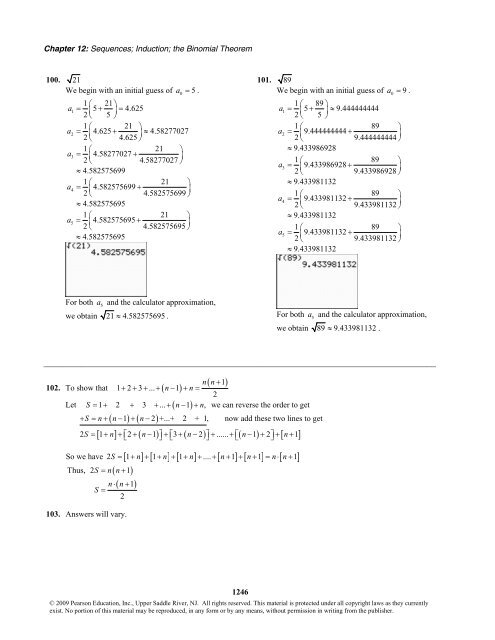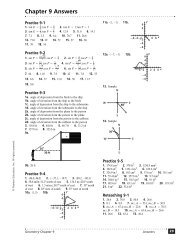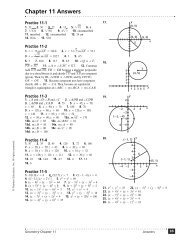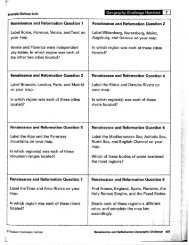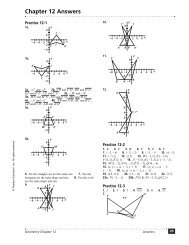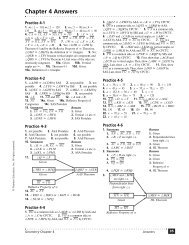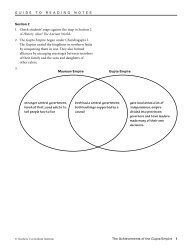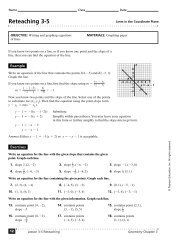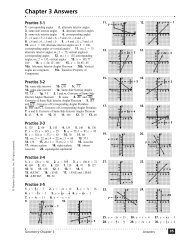Chapter 12 Sequences; Induction; the Binomial Theorem
Chapter 12 Sequences; Induction; the Binomial Theorem
Chapter 12 Sequences; Induction; the Binomial Theorem
You also want an ePaper? Increase the reach of your titles
YUMPU automatically turns print PDFs into web optimized ePapers that Google loves.
<strong>Chapter</strong> <strong>12</strong>: <strong>Sequences</strong>; <strong>Induction</strong>; <strong>the</strong> <strong>Binomial</strong> <strong>Theorem</strong><br />
100. 21<br />
We begin with an initial guess of a<br />
0<br />
= 5 .<br />
1⎛<br />
21⎞<br />
a1<br />
= ⎜5+ ⎟=<br />
4.625<br />
2⎝<br />
5 ⎠<br />
1⎛<br />
21 ⎞<br />
a2<br />
= ⎜4.625 + ⎟≈<br />
4.58277027<br />
2⎝<br />
4.625⎠<br />
1⎛<br />
21 ⎞<br />
a3<br />
= ⎜4.58277027<br />
+<br />
⎟<br />
2 ⎝<br />
4.58277027 ⎠<br />
≈ 4.582575699<br />
1⎛<br />
21 ⎞<br />
a4<br />
= ⎜4.582575699<br />
+<br />
⎟<br />
2 ⎝<br />
4.582575699 ⎠<br />
≈ 4.582575695<br />
1⎛<br />
21 ⎞<br />
a5<br />
= ⎜4.582575695<br />
+<br />
⎟<br />
2 ⎝<br />
4.582575695 ⎠<br />
≈ 4.582575695<br />
101. 89<br />
We begin with an initial guess of a<br />
0<br />
= 9 .<br />
1⎛<br />
89⎞<br />
a1<br />
= ⎜5 + ⎟≈9.444444444<br />
2⎝<br />
5 ⎠<br />
1⎛<br />
89 ⎞<br />
a2<br />
= ⎜9.444444444<br />
+<br />
⎟<br />
2 ⎝<br />
9.444444444 ⎠<br />
≈ 9.433986928<br />
1⎛<br />
89 ⎞<br />
a3<br />
= ⎜9.433986928<br />
+<br />
⎟<br />
2 ⎝<br />
9.433986928 ⎠<br />
≈ 9.433981132<br />
1⎛<br />
89 ⎞<br />
a4<br />
= ⎜9.433981132<br />
+<br />
⎟<br />
2 ⎝<br />
9.433981132 ⎠<br />
≈ 9.433981132<br />
1⎛<br />
89 ⎞<br />
a5<br />
= ⎜9.433981132<br />
+<br />
⎟<br />
2 ⎝<br />
9.433981132<br />
⎠<br />
≈ 9.433981132<br />
For both a<br />
5<br />
and <strong>the</strong> calculator approximation,<br />
we obtain 21 ≈ 4.582575695 .<br />
For both a<br />
5<br />
and <strong>the</strong> calculator approximation,<br />
we obtain 89 ≈ 9.433981132 .<br />
_________________________________________________________________________________________________<br />
102. To show that 1 2 3 ... ( n 1)<br />
( + 1)<br />
n n<br />
+ + + + − + n =<br />
2<br />
S = 1 + 2 + 3 + ... + n− 1 + n, we can reverse <strong>the</strong> order to get<br />
Let ( )<br />
+ S = n+ ( n− ) + ( n−<br />
)<br />
1 2 +...+ 2 + 1, now add <strong>the</strong>se two lines to get<br />
[ ] ⎡ ( ) ⎤ ⎡ ( ) ⎤ ⎡( ) ⎤ [ ]<br />
2S = 1+ n + ⎣2 + n− 1 ⎦+ ⎣3+ n− 2 ⎦+ ...... + ⎣ n− 1 + 2⎦+ n+<br />
1<br />
So we have 2S = [ 1+ n] + [ 1+ n] + [ 1 + n] + .... + [ n+ 1] + [ n+ 1] = n⋅ [ n+<br />
1]<br />
Thus, 2S<br />
= n( n+<br />
1)<br />
n⋅ ( n+<br />
1)<br />
S =<br />
103. Answers will vary.<br />
2<br />
<strong>12</strong>46<br />
© 2009 Pearson Education, Inc., Upper Saddle River, NJ. All rights reserved. This material is protected under all copyright laws as <strong>the</strong>y currently<br />
exist. No portion of this material may be reproduced, in any form or by any means, without permission in writing from <strong>the</strong> publisher.


